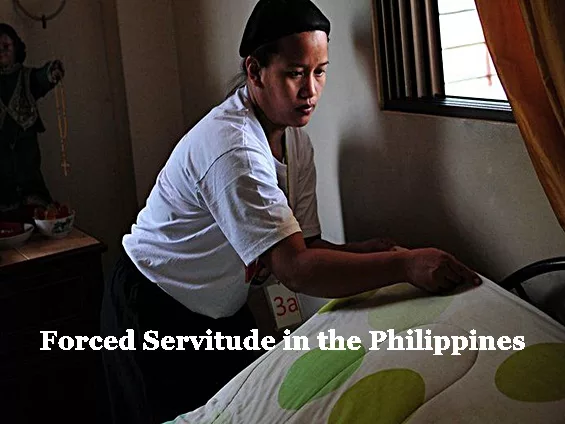The following article was written in 2018 but is still relevant today
As I am getting my daily dose of current events updates from a local newspaper on Monday, I came across an op-ed article titled, “The Philippines: A Nation of ‘Lolas’ and Slaves,” which stirred a lot of thoughts, emotions and reactions in me. It also made me think about the article that caught my attention online titled, “My Family’s Slave,” which has now become viral and has sparked debates and criticisms all over the world.
In the Philippines, middle-class families are often raised by nannies, while the elites have a handful of servants to take care of them. This reality, however, is not only seen in the Philippines, but also evident in other Southeast Asian nations. But do we really need these servants to live?
I, myself, was guilty of the fact that I was once raised by nannies as it was a norm while growing up. In fact, my sisters also have their own, as well as my cousins and other relatives. I am not patronizing nor demonizing servitude in Filipino households since families often hire servants not for the sole reason that they are unable to clean their own homes and raise their own children. Maids are hired out of rationality, while some may admit that they can’t afford to raise a family if both parents are not working.
But in a nation beleaguered by poverty, who are we to judge if thousands of people choose to cross oceans to raise other nations’ children or clean homes in a foreign land to earn money? Beyond the depiction of adversities, economic emotions and homesickness, this powerful sociological and cultural issue of servitude captured how unique, articulate, creative, steadfast, industrious and selfless most Filipinos are. Unfortunately, not everyone is given the right and chance to serve, be paid, be protected and be free.
Prevalence of Modern Slavery
Who could ever forget the depictions of slavery in many noteworthy Hollywood films and series like “Amistad,” “Lincoln,” “Django Unchained,” “12 Years A Slave,” “Birth of the Nation,” and “Roots: The Saga of the American Family?” Unfortunately, the prevalence of slavery in the world is far from what we often see, heard or read in the scripted tales, bestselling novels and award-winning films.
Based on the Global Slavery Index 2016, there are 45.8 million people who are living in modern slavery worldwide and 58 percent of whom are found in Asian countries such as India, China, Pakistan, Bangladesh, Uzbekistan, North Korea, Qatar, Iraq, Cambodia and Myanmar. In the Philippines, which ranked 33rd in the list of 167 nations, an estimated 401,000 (0.40 percent) of its population are living in modern slavery.
Even though the Philippines saw an improvement in its ranking from being the 19th in 2014, the fact can’t be denied that 47.67 percent of Filipinos remain vulnerable to modern slavery, “which could be through mental physical threat or coercion at work, ownership or control by en “employer” through mental or physical abuse, dehumanization or treatment as a commodity, or constraints placed on freedom of movement,” as per PhilStar Global.
The survey also highlighted the sad reality that Filipinos are enslaved through commercial sexual exploitation, child soldiery, forced labor or the most dangerous and controversial net fishing practice known as “Pa’aling” fishing, which is derived from the officially outlawed technique called Moro Ami, that involves divers using flimsy pipes attached to a surface air compressor.
As we live in a modernized era where technology thrives, slavery could be depicted in different ways such as through mental and physical threat. “Coercion at work, ownership or control by an ‘employer’ through mental or physical abuse, dehumanization or treatment as a commodity, or constraints placed on freedom of movement,” are also considered forms of modern slavery.
BAYAN USA also noted some forms of exploitation among workers, which include “no compensation, low wages, unstable working conditions, contractualization, physical and sexual abuse and wage theft.”
Human Trafficking and Forced Labor
Apart from life-long servitude, Filipinos are also falling victims to commercial sexual exploitation, forced labor and human trafficking across the Middle East, Asia, North America and Europe. One of the reasons why many prospective migrants are exploited is due to lack of knowledge or education when it comes to the processes and their rights. Hence, they often end up being abused.
But again, the Philippines is not the only country with a high rate of forced labor victims worldwide. As a matter of fact, a 2012 data from the International Labor Organization revealed that there was an estimated 21 million victims of forced labor globally.
Fortunately, the Philippine government has reportedly “introduced a response” to the growing issue of modern slavery. A Walk Free Foundation study revealed the government’s response to address the issue that includes the creation of a government-run or supported agency that will coordinate the response, protection for the victims, a criminal justice system that outlaws the forms of slavery and a short-term victim support services.
Why Slavery Must End
The issues on slavery, forced labor and women’s servitude in the Philippines became the talk-of-the-town when the late Pulitzer awardee Alex Tizon hauntingly described the ordeals of his “Lola” (Grandma in English), Eudocia Tomas Pullido in his article, “My Family’s Slave.” However, Pullido was not Tizon’s true relative but the family’s slave.
The Tizon family’s dirty secret of having a slave received a massive backlash from the West, but for those who have been raised by “lolas,” “nanays” or “yayas,” we hesitate to deprecate or judge. Instead, some offered their sympathy because this heartbreaking story is true and a reality, especially for many Filipino women.
Even though the concept of slavery is considered repugnant in modern times, the fact that it still exists and has become rampant is simply undeniable. But for Walk Free Foundation chairman and founder Andrew Forrest, slavery, which he described as “a human condition of our own making,” is “entirely avoidable” and must end.
Forrest added that it is “wise and urgent” for world leaders to improve the rights of millions of people who are enslaved. He said, “We cannot allow future generations to fall prey to this hideous practice. Eradicating slavery makes sense, morally, politically, logically and economically.”
Why Slavery is Somehow Acceptable
Speaking of slavery, Tizon’s unsettling yet poignant essay drew a lot of reactions and criticisms from its readers. The debate on whether or not Tizon’s article should be celebrated was widely discussed by several publications. There’s also an urgency to ensure this abhorrent practice won’t happen again.
Yet, if we delve deeper into the historical and cultural influences of the Philippines, people may somehow understand why the concept of slavery became acceptable. According to PRI, the Philippines is a nation with a long history of colonialism — being under Spain’s control for more than three centuries and the U.S. for almost five decades. So, it’s really not surprising to know that the country’s colonial past continues to form and influence “power structure” and its economy.
The long history of colonialism also highlighted the gap between the powerful and the elites, and the poor. Hence, domestic servitude in the forms of nannies, helpers, housekeepers and maids became somewhat a norm in the country. In fact, you don’t have to be rich to hire house helpers because even the working- and middle-class families hire them.
Another factor to consider is again the never-ending issue of poverty. Oftentimes, destitution becomes a “driving factor” of slavery for people and families at the bottom of the societal hierarchy. And since these kinds of situation habitually happens within the private vicinity of a household, ensuring these people are being treated fairly becomes pretty challenging, emphasizing the possibilities for abuse.
Are Filipinos Complicit to Slavery?
As the debate on slavery and Tizon’s essay intensified, another powerful piece titled, “We Are All Tizons” by Shakira Sison of Rappler struck me, making me realized that Pullido’s story is only one of those unheard of. Domestic helpers are also not the only ones suffering from this social and cultural injustice as thousands of workers here and abroad suffer the same fate.
That is why Sison is urging the Filipinos all over the world to reflect on the power dynamic behind the concept of slavery and devise a plan to completely eradicate it. She also left a powerful message that will make us realize that maybe, we, in one way or another, are complicit to slavery.
“Stop treating your helpers’ employment as a favor to them,” Sison wrote.
Women’s Servitude: A Life in Invisible Shackles?
Even though the story of Pullido is a tragic reality, it is uncomfortably familiar that many Filipinos can relate to — a power structure that is entrenched in the society. In Filipino culture, slaves may come with different names such as “kasambahay or home companion,” “utusan or the one commanded,” “katulong or helpmate,” or “yaya or nanny,” but they only connote one thing — servitude.
While the name keeps changing, its core remains the same, which is living a life of a prisoner in invisible cells and shackles. In a BBC article, Filipina author Ninotchka Rosca described the “power relationship” between the masters and the servants as “of the family, but not in the family.”
Rosca also highlighted that surviving a life of servitude means that one should “be groomed by culture, tradition and authority.” She also took notice of the fact that “class and color do correlate” in the country in which servants are often “browner” and come from rural areas.
These servants may not be bounded by iron shackles literally but their lives might as well have been. They live a life of commands, orders and rules. They are tongue-lashed, belittled and abused. With food, shelter and protection, these people are blinded with the promise of survival (and perhaps for some, a brighter future for them and their families) in exchange of labor and life-long servitude.
Since life-long servants are common in the Philippines, as well as in other Southeast Asian nations, the enslavement of Pullido only mirrors the lives of millions of Filipinas who sacrificed homesickness and the opportunity to raise their own families to be domestic workers and raise other nations’ children.
But can we really blame them if they choose to go overseas to provide their families comfort and a better life? I, myself, is sometimes wondering why my own sister would choose to leave the Philippines for a life in Canada, which my mom described as “lonely.” Many of my relatives also chose to leave home to seek better opportunities abroad. Even though they may not be slaves, they are still enslaved to the idea of having several options and great opportunities abroad to achieve their aspirations and dreams in life that often appeared impossible to pursue in the Philippine soil. But again, the question remains — who are we to judge?
I guess Rosca summed up the reality when it comes to servitude in her article by saying, “While today’s options for Filipinas may not be as limited as Ms. Pulido’s was, her story echoes the irony of fate for millions of Filipinas. To build a home at home, she has to leave home. She must be indentured to a stranger family, for her own family and the national home to survive.”
Self-Sacrifice vs. Selfishness
With Pullido’s heartbreaking tale of enslavement, the contradictions between self-sacrifice and selfishness becomes ironic. As every worker echoes Pullido’s portrayal of hardships in the hands of the masters, the eagerness to emancipate one’s family from poverty still prevailed. This scenario is especially true for OFWs who flee the country to seek a better future abroad.
Self-sacrifice is defined as the act of “giving up one’s own interest or wishes to help others.” John Milbank even described it as the “highest imaginable exemplification of sacrifice on behalf of others” or “the purest sacrifice imaginable.” Selfishness, on the other hand, is the complete opposite of self-sacrifice wherein it manifests concern or care for oneself.
While selfishness could reap unfathomable rewards, the act of self-sacrifice seems leading to nowhere. But despite it all, Filipinos remain steadfast and hopeful that perhaps someday, they could be completely freed from oppression and poverty. Who knows, the “Lolas” and other domestic workers or OFWs can have the opportunity and freedom to raise their own children and be with their families while they seek the future they always dreamed of.
Existence of House Servants: A Weird Practice for Westerners?
Tizon’s essay earned a lot of criticisms from Westerners, who are reportedly “puzzled” by the prevalence of having house servants, as Alex Almario of Philippine Star noted. But if we take the World History as basis, isn’t it true that the legacy of slavery continued to influence the history of the United States? In today’s generation, slavery is considered abhorrent yet it doesn’t give anyone the right to condemn a person whose biggest mistake was to reveal his family’s darkest secret of having a slave.
I am not urging nor suggesting for people to not express their thoughts, emotions and reactions to the issue. After all, we are living in a free nation, where freedom of speech and expression are essential. But as the rudiments of slavery turned into a chimera of abuse, violence and cruelty that ultimately demarcate nations and races, is it really worth it to blame, accuse and condemn? Perhaps, house servants is indeed a weird practice for Westerners but with their own history of slavery, compassion, understanding and sympathy are expected and not condemnation.
Modern-day slavery is outrageous and unfathomable but its existence is one of the universal truths that we all need to embrace and accept. Many may not understand, but if we open our hearts and minds, it’s a phenomenon that is far from weird as it is undeniably common and an uncomfortable societal norm that most people are familiar with and can relate to.
Slavery System in the Philippines
Tizon’s “My Family’s Slave” has indeed stirred a lot of debates and controversies. According to Caroline Hau of Rappler, “household work in general is devalued and poorly remunerated,” adding that “economists do not factor unpaid ‘household production’ or ‘own-production’ in their statistics.”
Hau also noted that measuring the quality of household productions remains a challenge for economists. She explained how household production labor is “sub-contracted by families” to their helpers and servants in the Philippines.
In Hau’s article, the writer also detailed the practice of slavery or servitude, which came with its “own specific history and system of social arrangement and relations.” The historical system of slavery and servitude, as well as the relationship between masters and servants in the Philippines are also greatly influenced by the Filipino perceptions on “mutuality, reciprocity, debt of gratitude (best known as “utang na loob” in Filipino), pity and shame.
“The thing about these so-called ‘Filipino values’ is that they work in a double-edged way: as much as they are often the only means by which the oppressed are able to assert their agency and human dignity against their oppressors, the language of reciprocity has also functioned historically to mask and enable the power dynamics of inequality and subordination,” Hau wrote.
The issues of “mutual help” and “unconscious paternalism” were also highlighted by Hau. But what is more interesting is the fact that the culture of slavery in the country is deeply rooted to “politics, economics and institutions.”
Virgilio A. Reyes of Inquirer, on the other hand, saw slavery as an “unexplored history and tradition” that make many Filipinos cringe to the idea that has existed for quite a long time. The questions he raised in his articles — “Why does 10 percent of our population work and live abroad? Why do we pride ourselves in being nannies or caregivers to the world? Why do we maintain a servile foreign policy in the process of changing our masters, protectors or so-called allies?” — all struck a nerve in every Filipinos.
Perhaps, it’s because for the reason of selflessness in which we often strive hard to provide for the needs of our loved ones, no matter what the cost. We take pride to serve others simply because we care and we are compassionate.
The sad tale of servitude, however, does not stop there or in Pullido’s experience as many Filipinos are still entrapped in this lingering and flourishing national repression. As a matter of fact, millions of overseas Filipino workers (OFWs) are still subjected to subhuman conditions and paid slave wages. However, this situation also lead to another tragic reality about the future of these workers in the Philippine soil, which is to stay in the country, work hard and end up earning less than the “slave wages” abroad.
With that said, the cliché “choosing the lesser of two evils” seems true. But with all the backlashing that comes with the issue of slavery, why not we all make Tizon’s piece as an inspiration for self-awareness that Pullido’s story is a reality, not only to Filipinos, but also to other races around the world.
Instead of condemning Tizon for not doing enough and sooner, why not we recognize his own efforts of making amends? If you were in Tizon’s shoes, what will you do? Most importantly, have you done something to stop slavery or forced labor in your country? It’s always easier said than done. So before we blatantly bash or criticize, it would be wiser to think first.
There may be some cultural gap that we might not recognize and understand but if we delve deeper into the issue, the cries that resonated from the Tizon’s story are the lamentations every human being yearn and strive for — freedom, respect, love and human rights.










